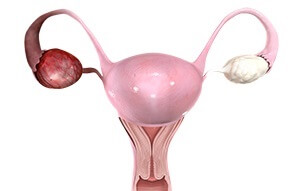
What are Ovarian Cysts?
Ovarian cysts are sacs filled with fluid that form inside or on the ovaries. Ovarian cysts are very common and often don't have any symptoms. They are usually harmless and may disappear without treatment.
Types of Ovarian Cysts
Functional cysts are the most common type of ovarian cyst, which are formed during the menstrual cycle. Functional cysts are usually benign. The two most common types of benign cysts include:
- Follicle Cysts: The follicle is the sac in which an egg grows and matures. Upon maturation, the follicle breaks and releases an egg every month. Follicle cysts form when the follicle does not break open to release the egg.
- Corpus Luteum Cysts: When the follicle sac does not dissolve after the egg is released, additional fluids accumulate inside the sac. This results in the formation of corpus luteum cysts.
Some women develop polycystic ovary syndrome, a condition in which the ovaries contain multiple cysts. If left untreated, polycystic ovary syndrome can cause infertility.
Malignant cysts are rare and are more common in older women.
Causes of Ovarian Cysts
Common causes include:
- Endometriosis
- Pregnancy
- Hormonal problems
- Severe pelvic infections
Symptoms of Ovarian Cysts
Most ovarian cysts don't cause any symptoms. If there are symptoms, they may include:
- Pressure
- Bloating
- Swelling
- Pain in the lower abdomen
Other less common symptoms include:
- Pelvic pain
- Pain in the lower back and thighs
- Trouble emptying the bladder completely
- Pain during sexual intercourse
- Weight gain
- Pain during your period
- Abnormal vaginal bleeding
- Breast tenderness
- Urinary urgency
Diagnosis of Ovarian Cysts
Your doctor will diagnose ovarian cysts by performing a pelvic examination to identify any swelling on the ovaries. Additionally, ultrasound may be ordered to help detect the location, shape, size, and mass of the cyst. A pregnancy test helps rule out pregnancy, and hormone levels are tested for any hormone-related problems. Your doctor may also order a blood test to check for cancer.
Treatment for Ovarian Cysts
In many cases, ovarian cysts disappear without treatment. Treatment is recommended when cysts do not go away on their own or grow larger. Often birth control pills are the first line of treatment recommended by your doctor. Oral contraceptive pills are prescribed to stop ovulation and the formation of new cysts. They also reduce the risk of developing ovarian cancer.
Surgery
If conservative treatment options are not successful, your doctor may recommend laparoscopic surgery to remove the cyst. This procedure involves making a tiny incision near your navel and removing the cyst by inserting a small instrument into your abdomen.
Your doctor performs laparotomy for removing larger cysts by making a large incision in your abdomen. For cancerous cysts, a hysterectomy is performed to remove the ovaries and uterus. Your doctor may order a biopsy to determine whether the cyst is cancerous or not.



